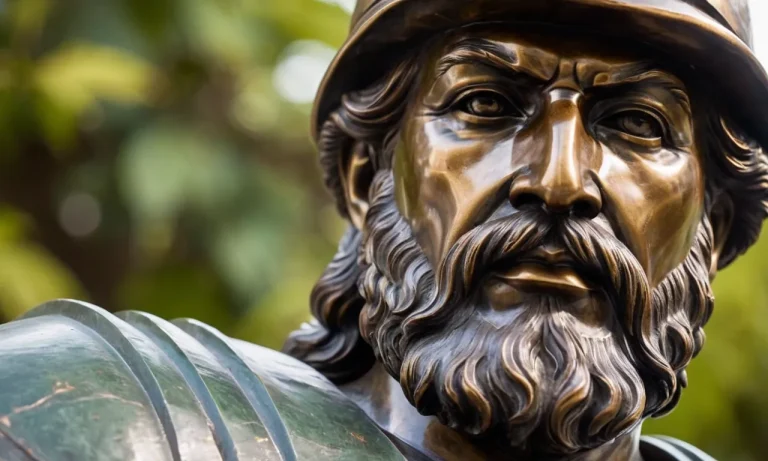Did Jesus Cover His Head When Praying?
Whether Jesus covered his head when praying is an interesting question for those looking to understand his practices and connect more deeply with their Christian faith. If you’re short on time, here’s a quick answer: There is no definitive evidence that Jesus specifically covered or uncovered his head when praying.
However, based on cultural norms of the time and region, it is likely that he would typically have worn some kind of head covering.
In this comprehensive article, we will analyze relevant biblical passages, cultural norms regarding head coverings in 1st century Judea, and theological symbolism regarding spiritual headship and submission.
By understanding this background, we can make an informed assessment about the likelihood of Jesus’ own practices regarding covering his head in prayer.
Relevant Biblical Passages About Head Coverings
Paul’s Letters Discussing Head Coverings in Worship
In 1 Corinthians 11:2-16, the apostle Paul provides guidance to the Corinthian church regarding head coverings during times of prayer and prophecy. He appeals to men and women to honor cultural conventions regarding head coverings, which signified humility and respect at that time.
Paul argues that when praying or prophesying publicly, “any woman who prays or prophesies with her head uncovered dishonors her head” (v.5). He reasons that having an uncovered head during worship is equivalent to having a shaved head, which was considered disgraceful for women in first-century Judean culture.
Paul goes on to state, “Judge for yourselves: Is it proper for a woman to pray to God with her head uncovered? Does not the very nature of things teach you that if a man has long hair, it is a disgrace to him, but that if a woman has long hair, it is her glory?” (vv. 13-15).
Here Paul appeals to prevailing cultural standards about gender-appropriate hair length and head coverings. He concludes that women following the customs of covering their heads during times of public prayer or prophecy shows respect for these cultural conventions and upholds order in Corinthian church gatherings.
While Paul grounds his instructions in the context of Corinthian cultural norms about head coverings, some scholars argue there may also be theological significance to his teaching. For example, some see head coverings as reflecting a creational order where man images God’s glory and woman reflects man’s glory (v.7).
Others interpret it as underscoring gender differentiation or female submission. Still, most agree that Paul’s main concern is maintaining decorum and avoiding offending cultural sensitivities in Corinthian worship.
Lack of Specific Mention of Jesus’ Head Covering Habits
The Gospels do not provide definitive detail on whether Jesus covered His head when praying or teaching. There are a few indirect references, such as the account of the sinful woman wiping Jesus’ feet with her hair (Luke 7:36-50).
Since this occurred at a banquet held by a Pharisee, where Jesus was presumably reclining at a low table, it seems He would not have been wearing any head covering at that time. However, this was not during formal prayer or prophecy.
In other scenes showing Christ at prayer, like when He prayed in Gethsemane before His crucifixion (Mark 14:32-42), there is no clear description regarding head coverings. It seems likely Jesus followed prevailing Jewish customs, which valued head coverings as symbols of humility before God.
Still, the Gospel accounts give no direct statement on Jesus’ own habits regarding wearing head coverings during times of prayer or ministry.
While Jesus often contended with Jewish authorities over legalistic applications of the law, He also demonstrated respect for the culture and traditions of Jewish piety. Regarding head coverings during prayer, Jesus likely adapted to customary practice as it suited the occasion.
His criticisms of outward religious practices targeted hypocrisy or lack of appropriate motivation, rather than enforcing rigid uniformity. Based on Christ’s approach to other issues of customary religious observance (like fasting or ceremonial handwashing), this seems an authentic approach regarding wearing head coverings while praying or teaching.
Cultural Norms Regarding Head Coverings in 1st Century Judea
Common Practice of Covering Heads in Worship and Public
In the 1st century Jewish and Greco-Roman cultures, both men and women commonly covered their heads in public as a sign of humility and respect. This was especially true during times of prayer and worship. Here are some details on the cultural norms surrounding head coverings at that time:
- Jewish men were expected to cover their heads with turbans or other cloth coverings as a sign of reverence when praying, studying Torah, or entering the temple. The Talmud states “Let not a man walk four cubits with his head uncovered” as a show of humility before God.
- Jewish women also covered their hair as a sign of modesty, often using scarves or veils. Married women in particular were expected to keep their hair covered in public.
- In Greco-Roman culture, head coverings showed social status. Upper class married women covered their hair with veils or hoods while working class women often went bareheaded.
- Roman men would pull the toga up over their heads or wear a cap called a pileus when worshipping their gods or at public sacrifices. Going bareheaded was seen as irreverent.
So in Jesus’ historical context, head coverings were a normal part of worship and public life for both men and women. The cultural expectation to have one’s head covered during prayer and in places of respect would have applied to Jesus as well.
Variations in Head Coverings Between Men and Women
While both men and women covered their heads in 1st century Judea, there were some differences in how they did so:
- Jewish men often wore turbans or cloth caps that covered the whole head. These were tied with leather straps under the chin to stay on.
- Jewish women wore lightweight scarves or shawls over their hair, shoulders, and back. These were loosely draped and tied under the chin.
- Wealthy Roman women wore elaborate headdresses called miters over braided hair. Poorer women used simple cloths or hoods.
- Roman men wore felt caps called pilei with floppy brims. Soldiers wore helmet style coverings with chin straps.
In religious life, Jewish men were careful not to obscure the phylacteries worn on the forehead and arm during prayer. Jewish women often wore veils that could be drawn over the face for modesty.
So while both genders covered their heads, men’s styles were often sturdier and wrapped fully around the head while women’s were loose drapes that framed the face. There was variation between different social classes as well.
But the purpose remained the same – to show humility before God and one’s fellow humans.
Theological Symbolism of Headship and Covering
The practice of women covering their heads during prayer or worship services has a long history in some Christian traditions. This practice is based on certain biblical passages (such as 1 Corinthians 11:2-16) which discuss symbolic issues around gender, headship, and spiritual coverings.
Man as Spiritual Head
1 Corinthians 11:3 states that “the head of every man is Christ, and the head of the woman is man, and the head of Christ is God.” This establishes a theological hierarchy with God at the top, followed by men in spiritual authority over women.
Angels Observe Spiritual Order
1 Corinthians 11:10 suggests that women should cover their heads “because of the angels.” Some believe this refers to angels observing human worship and expecting to see appropriate gender distinctions and spiritual headship symbolized.
A Sign of Authority
The text states that men having an uncovered head while praying or prophesying disgraces his spiritual “head” (Christ). But if a woman does so, she disgraces her spiritual “head” (her husband/father) in verse 5. Her covering is seen as a sign of male spiritual authority.
Hairstyles and Coverings
There are debates around whether the “covering” referred to is a veil, shawl, or even a woman’s long hair itself. But in any case, head coverings during this time held cultural significance regarding gender propriety, honor, and public reputation.
So in cultures that uphold male headship, female head coverings carry theological symbolism regarding spiritual order, authority, and appropriate gender dynamics. The practice seeks to honor divine order, ministry of angels, and male leadership during times of corporate worship according to this interpretation of Scripture.
Assessing the Likelihood Jesus Covered His Head When Praying
Determining whether Jesus covered his head when praying requires looking at cultural and religious practices during his time. As a Jewish man living in 1st century Judea, it is likely that Jesus would have followed common traditions for prayer.
Jewish Customs Regarding Head Coverings
In Jesus’ day, Jewish men commonly covered their heads during prayer as a sign of piety and reverence for God. This tradition came from passages in the Torah instructing the high priest to wear a turban (Exodus 28:4).
It later became customary for Jewish men to wear head coverings like kippahs or turbans while praying or studying scripture.
As an observant Jew, Jesus would have likely followed this tradition to show respect in God’s presence. However, the Bible does not specifically describe what Jesus wore on his head. The emphasis seems to be more on the posture and attitude of his prayers rather than specific garments.
Jesus’ Practices Regarding Prayer and Worship
The Gospels portray Jesus frequently going away to remote places to pray alone or with his disciples (Mark 1:35, Luke 5:16). His prayers demonstrated reverence and an intimacy with God as his loving Father (Matthew 6:9-13, 26:39).
When criticizing public displays of religion, Jesus stressed that the focus should be on the heart more than outward appearances (Matthew 6:5-6). So while he likely followed Jewish customs in his prayers, his main concern was having a humble and repentant spirit before God.
Conclusion
In closing, while the Bible gives no direct evidence about Jesus’ own habits regarding covering his head in prayer, based on cultural norms of his time and theological symbolism, it is likely he would typically have had his head covered, in keeping with common practices.
But the overarching focus for Christians would be spiritual modesty and submission to God, however it is expressed. This analysis aims to provide useful background for believers wanting to know more context about the question of Jesus covering his head.
But ultimately, our connection with Christ in prayer comes through the heart by the power of the Holy Spirit.








